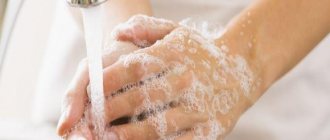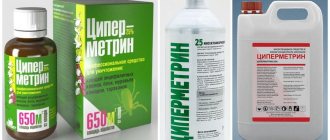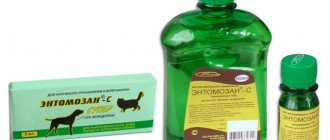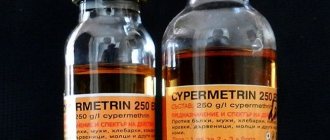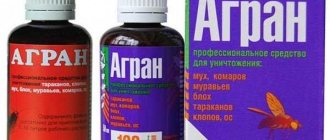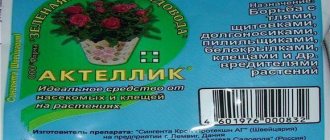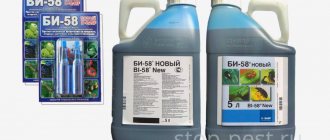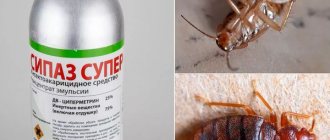Properties
The product has an acute insecticidal effect against cockroaches, ants, bedbugs, fleas, flies, mosquitoes, rat ticks and residual activity for 1-1.5 months.
According to the degree of impact on the body of warm-blooded animals, when introduced into the stomach, the product belongs to the 3rd class of moderately dangerous products, and with a single exposure to the skin - to the 4th class of low-hazard products according to GOST 12.1.007-76. Does not have a local irritant effect upon single exposure to the skin. A weakly expressed sensitizing effect was revealed. When exposed to the mucous membranes of the eyes, the product causes a pronounced effect (conjunctivitis); in the vapors of the working aqueous emulsion (0.1% by DV), the sensitizing effect has not been established, but a moderately pronounced irritant effect on the mucous membranes of the eyes has been detected. With a single inhalation exposure to an aerosol of 0.1% aqueous emulsion, the product in the zone of acute biocidal effect belongs to class 2, highly hazardous according to the Classification of the degree of hazard of disinfestation agents. Vapors of 0.1% aqueous emulsion in the zone of biocidal effect are classified as 4 low-hazardous in accordance with the Classification of the degree of hazard of disinfestation agents.
With repeated contact with intact skin of the working aqueous emulsion (0.1% DV), no skin-resorptive effect was detected, but a weakly expressed local irritant effect was established. The maximum permissible concentration in the air of the working area of the active substance - cypermethrin is 0.5 mg/m2 (vapor + aerosol) - hazard class 2.
Toxicity of Cypermethrin
Depending on where the treatment is carried out, Cypermethrin has different effects on a person. When disinfesting premises inside buildings, the drug is classified as a second hazard class, that is, highly dangerous substances. In open areas, the product has been assigned the third moderately dangerous class.
When using an insectoacaricide, it is imperative to follow safety precautions, which are described in great detail in the manual. Neglecting to use protective equipment such as gloves, goggles, a respirator, a gown or a protective suit can lead to cypermethrin poisoning.
Since the substance belongs to the group of cyanopyrethroids, the symptoms of intoxication when the chemical enters a person are neurotoxic in nature, namely:
- slower reactions;
- disturbance of gait and coordination of movements;
- involuntary drooling;
- CNS disorders and seizures.
If all rules are followed, the use of insectoacaricide does not pose a danger to people.
Purpose
The product is intended for the destruction of cockroaches, ants, bedbugs, fleas, flies, mosquitoes and rat mites in objects of various categories: in residential and non-residential premises, hotels, hostels, in public catering establishments (on weekends or sanitary days) by personnel of organizations engaged in disinfection activities , as well as to combat ixodid ticks (carriers of tick-borne encephalitis, Lyme disease and other diseases) when processing natural sites by professional contingent (employees of institutions authorized to engage in disinfection activities, supervisory authorities in the field of consumer rights protection and human well-being).
Danger of ticks
The most dangerous ticks for humans and their pets are those that live in forests. They carry serious diseases:
- tick-borne encephalitis,
- babesiosis,
- tick-borne typhus (typhus or relapsing),
- Lyme disease,
- ehrlichiosis.
There is another problem. Since it is extremely problematic to completely remove an attached parasite, its head often remains in the wound. It serves as a source of infection and/or inflammation.
Other types of mites - bed mites, scabies mites, subcutaneous mites, gamas mites - are less dangerous, although they cause discomfort at any time of the year. Allergies and bites are why they are a problem for many. They are not easy to detect, but there are signs indicating that ticks live in an apartment:
- the appearance of urticaria,
- exacerbation of bronchial asthma,
- severe itching all over the body.
If you find a tick, you should go to the hospital. Specialists will provide the necessary assistance to reduce the consequences of contact with a dangerous arthropod.
Using a product to kill arthropods indoors
- Destruction of cockroaches
To destroy cockroaches, 0.1% working water emulsions are used, selectively treating surfaces in places where insects are detected, localized and along the routes of movement of insects. Particular attention is paid to holes and cracks in walls, door frames, thresholds, along baseboards, in cladding, as well as ventilation vents, and the joints of pipes in water supply, heating, sewer and drainage systems.
Treatment is carried out simultaneously in all rooms inhabited by cockroaches. In case of high and very high numbers, adjacent premises are treated for preventive purposes: to prevent migration and subsequent colonization of cockroaches.
Repeated treatments are carried out when insects appear.
- Destruction of ants
To destroy red house ants and other species of ants that often enter premises, their paths of movement (“paths”) or places of accumulation are treated. A working aqueous emulsion of 0.05% (DV) concentration is used. Treatments are repeated when insects appear.
- Destruction of bedbugs
To kill bedbugs, use 0.05% (DV) aqueous working emulsions of the product. If the premises are sparsely populated, only their habitats are treated with bed bugs. In case of large occupancy and in the case of wall cladding with dry plaster, the places where they may be located should also be treated: cracks along skirting boards, borders, places where wallpaper is lagging, around door and window frames and ventilation grilles, cracks in walls, furniture, as well as carpets on the back side.
Simultaneous treatment of all premises is carried out only in dormitories, where frequent introduction of insects is possible.
Repeated treatments are carried out when bedbugs are detected.
- Destruction of fleas
To kill fleas, use 0.025% (DV) working water emulsion, treating walls (to a height of up to 1 m), the floor surface in places where linoleum and baseboards lag, cracks behind baseboards, carpets, paths on the back side.
When processing cluttered basements, these rooms are first cleared of debris if possible, and then thoroughly irrigated. Repeated treatments are carried out according to entomological indications.
- Killing flies
To destroy imagoes of house flies or other species of flies, use a 0.05% (DV) working water emulsion, which is used to irrigate the landing sites of flies in the premises, as well as the external walls of buildings, garbage containers, garbage chambers and sandblasting installations.
The emulsion consumption rate is 50-100 ml/m2, depending on the number of flies and the type of surface being treated.
Breeding sites for fly larvae (cesspools, waste, food waste), which are surrounded by objects, are also irrigated at intervals of 1 time every 20-30 days with an aqueous working emulsion of 0.05% (DV) concentration to prevent the flight of winged flies and their entry to the premises.
The consumption of working fluid when processing 1 m2 of substrate surface is: for liquid waste - 0.5 l, for solid waste - 1-3 l with a waste thickness of 50 cm and 3-6 l - with a thickness of more than 50 cm. For processing accumulations of domestic animal manure and substrate in landfills, the consumption is 2 liters if the larvae are concentrated in the surface layer.
Repeated treatments are carried out when winged flies appear in the room.
- Destruction of mosquitoes
To destroy adult mosquitoes, use a 0.025% (DV) working aqueous emulsion, which is used to irrigate mosquito landing sites indoors, as well as external walls of buildings or inside fences for garbage containers, where mosquitoes hide in hot weather.
To destroy mosquito larvae, a 0.01% (DV) working water emulsion is used, which is evenly sprayed over the surface of open natural reservoirs of non-fishery significance and urban reservoirs: basements of residential buildings, sewage, fire containers where mosquito larvae breed.
Consumption rate is 100 ml per 1 sq.m, water surface.
Repeated treatments are carried out according to entomological indications - the appearance of live mosquito larvae. Repeat treatments no more than once a month.
- Destruction of rat mites
To destroy rat mites, use a 0.05% (DV) working water emulsion, which is used to irrigate manholes, pipes of various communications, baseboards, walls and valleys along them, as well as places where mites may accumulate - heated areas of walls and floors near heating devices and thermal communications, the lower part of furniture, work tables, which are processed entirely, including the drawers in them. If there are false coverings behind which rodents can move, ceilings and walls must also be treated.
The consumption rate is 50-100 ml/m2 of working aqueous emulsion, depending on the type of surface being treated.
Repeated treatment is carried out according to indications, but not earlier than 20-25 days after the first.
Cypermethrin analogs
Cypermethrin is a substance that is included in many pesticides. The table below shows the drugs for use depending on the purpose.
| Application in agriculture | Application in private household plots | Use in everyday life |
| Vega | Alatar | Green House-Dust |
| Cyperus | Spark | Extermin-C |
| Shaman | Inta-Vir | Biocyfen |
| Volley | Shar Pei | Medilis-anti-BLOPS |
Over decades of professional use, Cypermethrin has proven itself to be an effective universal means of killing insect pests and mites. When using it on a personal plot, you should remember the precautions, and subsequently relax calmly and safely all summer without uninvited annoying “guests”.
Precautions when working indoors
- Treatment of premises should be carried out in the absence of people, pets, birds, fish, and with open windows. Food and utensils should be removed and carefully covered before processing.
- When treating workshops of industrial enterprises, first remove and carefully cover products that can adsorb the product.
- After treatment, the room should be well ventilated for at least 30 minutes.
- Treatment in children's and food institutions should be carried out on sanitary days or weekends.
- After disinsection, carry out wet cleaning of the room using a soap and soda solution.
- Premises treated with the product cannot be used until they are cleaned, which is carried out no later than 3 hours before using the facility for its intended purpose.
- Cleaning is carried out wearing gloves, using a soda solution (30-50 grams of soda ash per 1 liter of water).
- Those working with the product must observe the following precautions: before starting to work with the product, the exterminator provides instructions on safety precautions and first aid measures. Persons carrying out disinfestation, packaging of products, and preparation of emulsions must use personal protective equipment.
- Personal protective equipment includes: a cotton robe or overalls, a scarf, an oilcloth or rubberized apron and oversleeves, rubber technical gloves or cotton mittens with a film coating, sealed safety glasses (PO-2, PO-3, monoblock), universal respirators with a gas cartridge of the brand “A” (RU-60M, RPG-67 or gas mask, etc.)
- After finishing work, work clothes should be shaken out outside and washed. Wash it as it gets dirty, but at least once a week, after first soaking it (to neutralize dirt) in a hot soap-soda solution for 2-3 hours (50 grams of soda ash and 27 grams of soap per 1 bucket of water), then wash it in fresh soap and soda solution.
- When working with the product, be sure to follow the rules of personal hygiene. Smoking, eating and drinking in the treated area is prohibited. After finishing work, rinse your mouth, wash your hands and face with soap and water.
- Every 45-50 minutes of working with the product, you must take a break of 10-15 minutes, during which you must go out into the fresh air, taking off your gown, respirator or gas mask.
Preventing bed mites
Finishing the treatment of the apartment, many believe that this is all - the mites have disappeared and new ones certainly will not come. This is wrong. Every experienced exterminator knows that pests appear in residential premises because there are favorable conditions for their life. Prevention is a direct continuation of tick removal procedures.
The procedures presented below are relevant not only for bed mites, but also for other insects:
- Reduce the number of so-called dust collectors - curtains, soft toys, etc.
- Check pets regularly for lice and ticks.
- Carry out wet cleaning more often.
First aid for poisoning when working indoors
- If safety rules are violated or in accidents, acute poisoning may develop. Signs of poisoning: unpleasant taste in the mouth, weakness, vomiting, headache, nausea (increased by smoking, eating), abdominal pain, irritation of the respiratory system, excessive salivation.
- In case of poisoning through the respiratory tract, remove the victim to fresh air, remove contaminated clothing, and rinse the mouth with water or a 2% solution of baking soda. Then give 1-2 glasses of water with activated carbon (10-15 tablets) to drink.
- If you accidentally get the product into your eyes, rinse them thoroughly under running water or a 2% solution of baking soda for several minutes. If irritation of the mucous membrane occurs, drip a 30% solution of sodium sulfacyl into the eyes; if pain occurs, drop a 2% solution of novocaine into the eyes.
- If the skin is contaminated, remove drops of emulsion with a cotton swab or rag without rubbing; why wash the contaminated area with soap and water.
- If the product accidentally gets into the stomach, drink several glasses of water and induce vomiting, then rinse the stomach with a 2% solution of baking soda or drink 1-2 glasses of water with activated carbon (10-15 tablets). Never induce vomiting or put anything into the mouth of an unconscious person.
- After providing first aid, the victim should consult a doctor. Treatment is symptomatic.
Advantages and disadvantages of Cypermethrin
Advantages
- Destruction of a wide range of pest species;
- High initial activity;
- Long-lasting protective effect;
- Convenient preparation of working solution;
- Resistance to ultraviolet rays;
- Does not cause resistance;
- Easy post-treatment with alkaline preparations.
Flaws
- Specific smell;
- Since the impact does not extend to egg laying, the possibility of new treatments;
- Personal protective equipment is required during use;
- By using the substance on a personal plot, it is possible to destroy beneficial insects.
The use of a means for the destruction of ixodid ticks when processing natural sites
- Destruction of ticks is carried out in areas with a high risk of infection with tick-borne encephalitis or Lyme disease - areas of natural stations in places of economic activity (places of communication facilities, gas and oil pipelines, etc.) and recreation (tourist centers, sanatoriums, boarding houses, children's holiday camps etc.).
- They treat areas of the territory in order to protect the population (loggers, oil workers, drillers, tourists, vacationers, children in summer health camps, etc.) from attacks by ixodid ticks of the genus Ihodes (in the European part of the Russian Federation these are the forest tick I.ricinus and the taiga tick I.persulcatus, in the Asian part of the country - mainly I.persulcatus Haemaphysalis and Dermacentor, which are carriers of pathogens of dangerous diseases (TBE, ITB, tick-borne rickettsiosis, etc.) Territories frequently visited by people (paths, lawns, playgrounds, etc. .), must be mechanically cleared of vegetation and forest litter in which ticks may be located. The remaining herbaceous vegetation where ticks are found must be treated.
- When the treated area is located in a vast forest area that poses a risk of ticks, it is recommended to create a barrier, the width of which should be at least 50-100 m.
- Treatment is carried out 3-5 days before people visit the area.
- Treatment should be carried out if the weather forecast is favorable (no precipitation) for the next 3 days.
- The consumption rate of the working emulsion depends on the type of equipment used and the density of the vegetation cover. Typically, 100 liters of working emulsion are consumed per 1 hectare, but with dense vegetation cover, a larger amount is used.
- The application rate depends on the type and number of mites, as well as the density of the vegetation cover. To destroy ticks of the genus Hodes: with low numbers (up to 10 individuals/flago-kilometer during the period of maximum numbers and activity of ticks) and sparse vegetation cover, the application rate will be 0.25 l/ha: with medium and high numbers and dense vegetation cover - 0.75 l/ha, with rare -0.5 l/ha. For the destruction of ticks of the genus Dermasentor and Haemaphysalis - 1.2 l/ha.
- The validity period of the product against ticks in the litter is about 1-1.5 months. If there is a significant amount of precipitation, the effectiveness of the product may decrease. If necessary, due to the presence of ticks in the treated area, re-treatment is possible.
Cross use with other chemicals
There are a number of preparations in which cypermethrin is used in mixture with other insecticides to achieve greater effect:
- "Sichlor" - created on the basis of cypermethrin and chlorpyrifos;
- “Gulliver” - contains alpha-cypermethrin, lambda-cyhalothrin, thiamethoxam;
- "Killer" - contains cypermethrin and chlorpyrifos.
In the case of independently preparing mixtures, select insecticides that have mutually complementary properties. For joint use with cypermethrin, a substance is selected that affects insect eggs. It is unacceptable to use cypermethrin together with alkaline preparations.
Precautions when working in open areas
- Before starting work, the responsible work manager conducts special instructions on work rules, storage, precautions and first aid, familiarizes all workers with the characteristics of the product, its toxicity, as well as measures to prevent contamination of reservoirs, apiaries, etc. with the product.
- When processing natural sites, it is necessary to comply with the water protection zones of rivers, ponds, lakes, reservoirs, zones of the first and second zones of sanitary protection of water supply sources and air intake devices. It is prohibited to cultivate areas located near fishing and drinking water bodies at a distance of 500 m from the flood line at maximum flood waters, but not closer than 2 km from the existing banks. Grazing of livestock, picking berries and mushrooms in the treated area is permitted no earlier than 40 days after treatment.
- The population living near the treated area must be informed in advance about the places and timing of the treatments (radio, television or written notification). Uniform safety signs are placed at the border of the treated area; the signs are removed after the established deadlines. The information should include the following information: the danger of tick vectors, the need for treatment, the safety of the product in the recommended mode of use for human health and for the preservation of natural biotopes, the prohibition of grazing livestock, picking berries and mushrooms in the treated area.
- The use of the product requires compliance with the basic provisions of the “Instructions for the prevention of bee poisoning by pesticides” (M., GAPSSSR, 1989). It is necessary to promptly notify the owners of apiaries about the places and timing of treatments (at least 2 days before treatments) and the need to protect bees. Treatment times are morning and evening. Treatment is carried out using low-volume ground spraying at wind speeds of up to 1-2 m/sec. In order to protect apiaries from the effects of the product, it is necessary to take them to another source of honey collection at a distance of at least 5 km from the treated areas (border protection zone) and isolate them in any way for up to 10 days after treatment. The summer limit for bees is 96 -120 hours.
- The preparation of aqueous emulsion and filling of containers is carried out at specially equipped filling points. The refueling point should be located no closer than 200 m from livestock grazing areas and water bodies. If the soil is accidentally contaminated with the product, it is disinfected.
- Places where work is carried out with the product are supplied with water, soap, towels and a first aid kit.
Preparation before treatment for bedbugs
Before we start processing, we will clean with a vacuum cleaner. Mechanical processing will help us partially destroy individual individuals, open nests and determine the degree of contamination of the room.
- Next, we clear the room of people and pets.
- We move the furniture away from the walls.
- We remove curtains and curtains.
- If you have an aquarium, take it out or cover it tightly.
- Remove indoor plants from the room.
- Place food in cabinets and pack it in plastic bags.
- Personal hygiene products and cosmetics should also be packed in bags.
- Remove bedding.
Neutralization and removal when working in open stations
- Decontamination of protective clothing and product containers is carried out using personal protective equipment in the open air at a distance of at least 500 m from residential premises, food facilities and bodies of water. All neutralization work is carried out under the guidance of persons responsible for using the product.
- Vehicles contaminated by the product (wooden parts of cars, etc.) are treated at least 2 times a month with bleach slurry (1 kg per 4 liters of water) for 1 hour, then washed off with water.
- The soil contaminated with the product is neutralized with bleach and then dug up. The neutralized residues of the product and rinsing water are buried in a hole 0.5 m deep in places approved by Rospotrebnadzor authorities. If there are pastures in the work area, holes are dug at a distance of no closer than 1 km from them.
Bedbug treatment areas
House bugs feed on our blood, and since they are not particularly mobile, we look for them around our resting place. We process:
- Mattresses, bed frames and interior niches of upholstered furniture.
- Upholstery seams, locks, labels.
- Gaps in the floor and baseboards.
- Bedside furniture, bedside tables, chest of drawers, etc.
- The back side of carpets, paintings, sconces and floor lamps.
- Heating panels and window sill spaces.
- It is possible that bedbugs came running from neighbors; for prevention, treat ventilation plenums, door frames and window frames.
We leave the room for 3 - 5 hours (it is possible to leave it longer), and upon return, ventilate well. And wet clean the contact surfaces of door handles, table shelves, etc. with a water-soda solution. Carry out a complete cleaning after 2 - 3 days, the number of corpses will show you the result of the treatment.
Advantages
Many exterminators, owners of private houses and city apartments choose preparations based on the active substance cypermethrin to destroy parasites that have settled in the home. The popularity of the products is easy to understand if you read reviews and find out the opinions of experts.
Among the "pros":
- active influence on various types of pests;
- several forms of release;
- ease of use;
- resistance to sunlight;
- the product does not change properties under the influence of an acidic environment;
- After treatment, the surface can be easily washed off from the solution, powder or concentrated emulsion using alkaline agents;
- convenient packaging;
- medium toxicity class;
- reasonable price.
Content
- Purpose and application
- Composition and dosage form
- Mechanism of action
- Regulations for the use of the drug "Cypermethrin 25, EC"
- Compatibility
- Analogues and preparations containing cypermethrin
- Security and restrictions
- Advantages and disadvantages of application
- Advantages of using the drug "Cypermethrin 25, EC"
- Disadvantages of using the drug "Cypermethrin 25, EC"
"Cypermethrin" is an effective drug with a wide spectrum of action. The material contains the purpose, composition, mechanism of action, regulations for use, restrictions, analogues, etc.
Description of the drug
The insecticide has an effect at all stages of insect development: from larva to adult. The poison enters the body of insects through the intestinal tract along with food, through the skin. Cypermethrin is capable of destroying up to 95% of all types of insects: domestic and garden.
The drug is available in different forms:
- water soluble powder;
- concentrated emulsion;
- mother liquor;
- pills.
This substance is white in color, without a pronounced odor. Only liquid preparations are put on sale, since the dissolution of a powdery substance requires compliance with special conditions of equipped production premises.
Cypermethrin is available in three forms of repellent:
- alpha;
- beta;
- zeta.
Alpha Cypermethrin has an immediate effect on the nervous system of insects and also destroys arthropods. It has a long residual effect, so it can eliminate a lot of insects in 4 weeks.
Beta Cypermethrin is highly toxic to humans and warm-blooded animals, therefore it is used exclusively in open areas.
Zeta Cypermethrin is widely used in forestry and agriculture, as it actively destroys parasites on cereals, on the bark of fruit and coniferous trees.
These three types of the drug have an equally destructive effect on insects. They differ from each other by the speed of penetration of insects into the gastrointestinal tract and the beginning of immobilization of parasites.
Peculiarities
- High efficiency;
- resistant to solar radiation;
- resistant to high temperatures;
- has a long residual effect (up to 30 days);
- washes off well with detergents.
The effectiveness of the drug is explained by the dual action of its formula - insecticidal and acaricidal. That is, the substance is equally dangerous for blood-sucking spiders and arachnid mites.
The poison enters the insect's esophagus and paralyzes the nerve endings. As a result, insects die from complete immobilization and starvation.
Flaws
- Does not affect egg laying;
- high toxicity class for warm-blooded animals;
- has a detrimental effect on the inhabitants of water bodies;
- It is necessary to strictly observe safety precautions when using the drug.
If the insects have already laid eggs, then new individuals will hatch from them. Therefore, the territory is treated repeatedly. It is necessary to treat the garden plot with great care: the drug can kill all the bees. A huge disadvantage of the drug is that in order to effectively kill parasites, the entire area has to be treated completely. This is fraught with the destruction of beneficial individuals: bees.
Due to the high toxicity class, all dishes and cutlery must be carefully packed when processing the premises. If this is not done, you can get poisoned by using contaminated utensils. When treating a living space, you should not go inside until the effect of the drug has completely worn off.
Bottom line
Cypermethrin is effective against all known crawling and flying insects. This is a universal insecticide and acaricide; it can be used to successfully fight ticks. Cypermethrin is used for disinsection of premises and open areas; the dosage of the substance is indicated in the instructions. Since insecticides are toxic hazardous substances, care and caution are required when working with them.
Sources used:
- Pests of agricultural crops and forest plantations: monograph. / V.P. Vasiliev. - M.: Book on Demand, 2012.
- Calendar-guide for pest and disease control in gardens (for non-chernozem zone) / N.A. Ivanova, A.A. Shumakova. — M.: Kolos
- Wikipedia article
- Handbook of plant protection for gardeners and gardeners / S.K. Grebenshchikov. - M.: Rosselkhozizdat, 1987.
